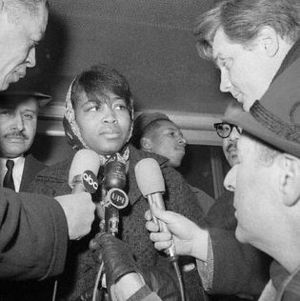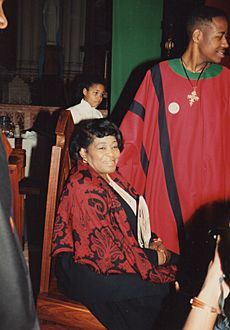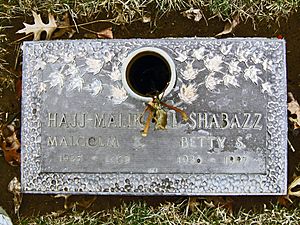Betty Shabazz facts for kids
Quick facts for kids
Betty Shabazz
|
|
|---|---|
 |
|
| Born |
Betty Dean Sanders
May 28, 1934/1936 Pinehurst, Georgia, U.S.
|
| Died | June 23, 1997 (aged 61 or 63) New York City, New York, U.S.
|
| Resting place | Ferncliff Cemetery |
| Other names | Betty X |
| Education | Tuskegee University Brooklyn State College School of Nursing |
| Spouse(s) | |
| Children | 6, including Attallah, Qubilah, and Ilyasah |
| Relatives | Malcolm Shabazz (grandson) |
Betty Shabazz (born Betty Dean Sanders; May 28, 1934/1936 – June 23, 1997), also known as Betty X, was an American educator and a strong supporter of civil rights. She was married to the famous civil rights leader Malcolm X.
Betty grew up in Detroit, Michigan, where her foster parents tried to protect her from racism. She went to the Tuskegee Institute in Alabama, where she first experienced racism directly. Because she was unhappy in Alabama, she moved to New York City and became a nurse. There, she met Malcolm X and joined the Nation of Islam in 1956. She and Malcolm X married in 1958.
Betty and Malcolm X left the Nation of Islam in 1964. Sadly, she saw him killed the next year. As a widow, Betty had to raise their six daughters. She went back to school to get more education and then worked at Medgar Evers College in Brooklyn, New York.
In 1995, her daughter Qubilah was arrested. Betty then took in her ten-year-old grandson, Malcolm. In 1997, a tragic accident involving her grandson led to a fire in her apartment. Betty suffered serious burns and passed away three weeks later from her injuries.
Contents
Early Life
Betty Dean Sanders was born on May 28, 1934 or 1936. Her birth records are a bit unclear, but she was likely born in Pinehurst, Georgia. She always said she was born in Detroit.
When Betty was about 11 years old, she was taken in by Lorenzo and Helen Malloy. They were a well-known couple in Detroit. Helen Malloy helped start a group called the Housewives League of Detroit. This group of African-American women worked to support businesses owned by black people. They also encouraged people to avoid stores that wouldn't hire black employees. The Malloys were also active in their church and in civil rights groups like the National Council of Negro Women and the NAACP.
Even though the Malloys taught Betty about black self-reliance, they didn't talk to her about racism. Betty later said that they hoped ignoring race problems would make them disappear. However, two race riots happened during her childhood, in 1942 and 1943. These events shaped her early years and made her aware of racial tensions.
Young Adult Years
After high school, Betty left Detroit to study at the Tuskegee Institute in Alabama. This was a historically black college. She planned to become a teacher. When she arrived in Alabama, she quickly realized what her foster mother had been worried about.
Betty was not prepared for the racism she found in the South. While on campus, she could avoid white people. But trips into Montgomery, the nearest city, were frustrating. Black students often had to wait until all white customers were served before they could get help in stores. When she told the Malloys, they didn't want to talk about it.
Because of her frustration, Betty's studies suffered. She decided to change her major from education to nursing. Her nursing dean suggested she study in New York City. So, in 1953, Betty left Alabama for New York.
In New York, Betty faced a different kind of racism. At Montefiore Hospital, where she trained, black nurses were given harder tasks than white nurses. Some white patients were also unkind to black nurses. Even though New York was better than Alabama, Betty often wondered if she had just traded one type of prejudice for another.
Joining the Nation of Islam
During her second year of nursing school, Betty was invited to a dinner party at the Nation of Islam temple in Harlem. She loved the food. After dinner, she was asked to attend a lecture. Betty agreed. She was then invited to join the Nation of Islam, but she politely said no. She explained that she didn't understand their beliefs and her Methodist foster parents would be very upset.
The nurse's aide told Betty about their minister, Malcolm X. She said he was very disciplined and impressive. Betty enjoyed the food so much that she agreed to come back and meet him. When she saw Malcolm X, she was very impressed. She later remembered him "galloping to the podium" and how she "sat up straight" when he started speaking.
Betty met Malcolm X again at another dinner. They talked for a long time about her life, her childhood, and the racism she had faced. He explained the challenges faced by African Americans and the reasons for racism. Betty began to see things differently. She felt that Malcolm X understood her feelings about her experiences in the South.
Soon, Betty went to all of Malcolm X's lectures at Temple Number Seven in Harlem. He always sought her out afterward and asked her many questions. Betty admired Malcolm X's leadership and his dedication to helping others. She felt he was selfless but had no one to rely on himself. She thought she could be that person. He also encouraged her to join the Nation of Islam. In mid-1956, Betty converted. Like other members, she changed her last name to "X." This "X" stood for the unknown family name of her African ancestors.
Marriage and Family Life
Betty X and Malcolm X did not have typical dates. The Nation of Islam's rules did not allow one-on-one dates. Instead, they went on group outings with other members. Malcolm X often took groups to visit museums and libraries in New York, and he always invited Betty X.
Betty X suspected Malcolm X wanted to marry her, even though they never talked about it directly. One day, he called and asked her to marry him. They were married on January 14, 1958, in Lansing, Michigan. On the very same day, Betty X also became a licensed practical nurse.
At first, their marriage followed the strict rules of the Nation of Islam. Malcolm X set the rules, and Betty X followed them. But over time, their family life changed. Malcolm X started to allow Betty X more independence. Betty later recalled that Malcolm realized their marriage should be a "mutual exchange" where both partners shared their thoughts and expectations.
The couple had six daughters:
- Attallah, born in 1958.
- Qubilah, born in 1960.
- Ilyasah, born in 1962.
- Gamilah Lumumba, born in 1964.
- Twins, Malikah and Malaak, born in 1965 after their father's death.
Leaving the Nation of Islam
On March 8, 1964, Malcolm X announced that he was leaving the Nation of Islam. He and Betty X, who became known as Betty Shabazz, then became Sunni Muslims.
The Death of Malcolm X
On February 21, 1965, Malcolm X was giving a speech in Manhattan when a disturbance broke out. As he tried to calm the crowd, a man rushed forward and shot him. Two other men also fired guns, hitting Malcolm X many times.
Betty Shabazz was in the audience with her daughters. When she heard the shots, she quickly grabbed her children and pushed them to the floor. She shielded them with her body to protect them. After the shooting stopped, Betty ran to her husband and tried to help him. Police officers took him to the hospital, where he was pronounced dead.
One of the attackers was caught and arrested at the scene. Eyewitnesses identified two more suspects. All three men, who were members of the Nation of Islam, were found guilty and sentenced to life in prison.
Life After Malcolm's Death
Immediately After
After Malcolm X's death, Betty had trouble sleeping and suffered from nightmares. She also worried about how she would support herself and her family. The book The Autobiography of Malcolm X helped, as Betty received half of the money from its sales. Later, the other half of the royalties was also given to her.
Friends like actress Ruby Dee and Juanita Poitier started a group called the Committee of Concerned Mothers. They raised money to buy a house and pay for the Shabazz family's education. They held concerts and raised $17,000, which helped them buy a large home in Mount Vernon, New York.
Betty later said that she first wanted to isolate herself because of the unfairness of her husband's death. However, she realized that giving up would not help her children or the world. She understood that she needed to be part of society for her children to grow and develop.
Pilgrimage to Mecca
In March 1965, Betty Shabazz made the pilgrimage to Mecca. This is a special religious journey for Muslims. Her husband had made the same journey the year before. Betty later said that going to Mecca helped her heal and get her life back on track. It made her focus on the people who supported her, instead of those who tried to hurt her family.
When she returned from Mecca, a fellow pilgrim gave her a new name, Bahiyah, which means "beautiful and radiant."
Raising Her Family
Raising six children by herself was very tiring for Betty. Providing for them was also a challenge. The money from The Autobiography of Malcolm X helped. In 1966, she sold the movie rights to the book. She also started allowing Malcolm X's speeches to be published, which gave her another source of income.
Betty became very involved in her daughters' day care center. She became an active member of the parents' organization and later became the parents' representative on the school board. After several years, she became president of the Westchester Day Care Council.
Betty also began to give speeches at colleges and universities. She often talked about Malcolm X's ideas about black nationalism. She also spoke about her role as a wife and mother. Betty felt that the media often showed her husband in a wrong way, making him seem violent or hateful. She wanted people to know he was a sensitive and understanding man with a realistic vision.
As her daughters grew up, Betty sent them to private schools and summer camps. They also joined Jack and Jill, a social club for children of successful African Americans.
Advanced Education
In 1969, Betty Shabazz went back to college at Jersey City State College. She finished her bachelor's degree in education in just one year. Then, she decided to earn a master's degree in health administration. In 1972, Betty enrolled at the University of Massachusetts Amherst to get her Ed.D. in higher education. For the next three years, she drove from Mount Vernon to Amherst every week. In July 1975, she earned her doctorate.
Medgar Evers College
In January 1976, Betty Shabazz became an associate professor of health sciences at New York's Medgar Evers College. Most of the students at Medgar Evers were black and from working-class families. Many of the teachers were black women, and most of the students were female, with two-thirds of them being mothers. These qualities made Medgar Evers College a good fit for Betty.
By 1980, Betty was in charge of the health sciences department. She was then promoted to Director of Institutional Advancement, where she helped promote the college and raise money. A year later, she was given tenure, which meant she had a permanent position. In 1984, she became the Director of Institutional Advancement and Public Affairs, a position she held until her death.
Volunteer Work
Betty Shabazz continued her volunteer work throughout the 1970s and 1980s. In 1975, President Ford asked her to join a council for the United States Bicentennial. She also served on an advisory committee for family planning for the U.S. Department of Health and Human Services. In 1984, she hosted a convention for the National Council of Negro Women in New York. Betty was also active in the NAACP and the National Urban League. When Nelson and Winnie Mandela visited Harlem in 1990, Betty was asked to introduce Winnie Mandela.
Betty became good friends with Myrlie Evers-Williams, the widow of Medgar Evers, and Coretta Scott King, the widow of Martin Luther King Jr.. They all shared the experience of losing their activist husbands at a young age and raising their children alone. The media often called them the "Movement widows" because they made many public appearances together. Myrlie Evers-Williams described Betty as a "free spirit" whose smile could "light up the whole room."
Louis Farrakhan
For many years, Betty Shabazz felt angry toward the Nation of Islam, especially Louis Farrakhan. She believed they played a part in her husband's death. In a 1994 interview, Betty said that Farrakhan "had something to do" with Malcolm X's death. Farrakhan denied being directly involved but admitted he "created an atmosphere that allowed Malcolm to be assassinated."
In January 1995, Betty's daughter, Qubilah Shabazz, was accused of trying to hire someone to kill Farrakhan. Surprisingly, Farrakhan defended Qubilah, saying he didn't think she was guilty. That May, Betty Shabazz and Farrakhan shook hands on stage at the Apollo Theater during an event to raise money for Qubilah's legal defense. This event raised nearly $250,000. After this, Betty kept a distant relationship with Farrakhan, though she did speak at his Million Man March that October.
Qubilah accepted a plea agreement for the charges. During her treatment, Qubilah's ten-year-old son, Malcolm, went to live with Betty at her apartment.
Death
On June 1, 1997, her 12-year-old grandson Malcolm accidentally started a fire in Betty's apartment. Betty suffered severe burns and stayed in the hospital for three weeks. She had several operations, but she passed away from her injuries on June 23, 1997. Malcolm Shabazz was sentenced to 18 months in juvenile detention.
More than 2,000 people attended a memorial service for Betty Shabazz at New York's Riverside Church. Many important leaders were there, including Coretta Scott King, Myrlie Evers-Williams, and poet Maya Angelou. President Bill Clinton also sent a tribute. Civil rights leader Jesse Jackson said that Betty "never stopped giving and she never became cynical."
Betty Shabazz's funeral service was held at the Islamic Cultural Center in New York City. Her public viewing was at the Unity Funeral Home in Harlem, the same place where Malcolm X's viewing had been 32 years earlier. Betty Shabazz was buried next to her husband, El-Hajj Malik El-Shabazz (Malcolm X), at Ferncliff Cemetery in Hartsdale, New York.
Memorials
In late 1997, a clinic in Brooklyn, New York, was renamed the Dr. Betty Shabazz Health Center in her honor. The Betty Shabazz International Charter School was founded in Chicago, Illinois, in 1998 and named after her. In 2005, Columbia University opened the Malcolm X and Dr. Betty Shabazz Memorial and Educational Center. This memorial is located in the Audubon Ballroom, where Malcolm X was killed. In March 2012, New York City co-named Broadway at West 165th Street, the corner in front of the Audubon Ballroom, Betty Shabazz Way.
Portrayals in Film and Television
Betty Shabazz has been shown in several films and TV shows:
- In the 2013 TV movie Betty & Coretta, she was played by Mary J. Blige.
- Angela Bassett played her in the 1992 film Malcolm X and in the 1995 film Panther.
- Yolanda King, the daughter of Martin Luther King Jr. and Coretta Scott King, played Betty in the 1981 TV movie Death of a Prophet.
- Victoria Dillard portrayed her in the 2001 film Ali.
- Joaquina Kalukango plays her in the 2020 film One Night in Miami....
- Grace Porter portrayed her in the second season of the 2019 TV series Godfather of Harlem.
Images for kids
See also
 In Spanish: Betty Shabazz para niños
In Spanish: Betty Shabazz para niños





